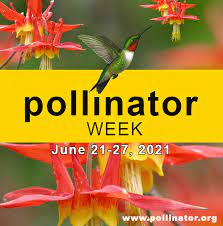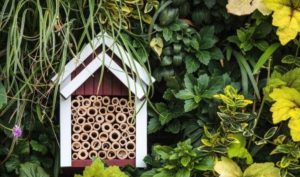Are you one of those that hear the word “pollen” and sneeze? For many, allergies are the only association with plant pollen. But pollination – the transfer of male pollen grains into the female flower organs to create fertile seeds – is an essential part of a healthy ecosystem. Pollinators play a significant role in the production of over 150 food crops. Corn and rice are wind pollinated. Just about everything else, including chocolate, depends on an insect, bird or mammal. Successful pollination of a single flower often requires visits from multiple pollinators. But, there are also plants that need a specific species in order to complete the task. They are so interdependent that if one disappears, so will the other.
Unfortunately, reports from the National Research Council say that the long-term population trends for some North American pollinators are “demonstrably downward”.
 In 2007, the U.S. Senate unanimously approved and designated “National Pollinator Week” to help raise awareness. National Pollinator Week (June 21-27, 2021) is a time to celebrate pollinators and spread the word about what you can do to protect them. Habitat loss for pollinators due to human activity poses an immediate and frequently irreversible threat. Other factors responsible for population decreases include: invasive plant species, broad-spectrum pesticide use, disease, and weather.
In 2007, the U.S. Senate unanimously approved and designated “National Pollinator Week” to help raise awareness. National Pollinator Week (June 21-27, 2021) is a time to celebrate pollinators and spread the word about what you can do to protect them. Habitat loss for pollinators due to human activity poses an immediate and frequently irreversible threat. Other factors responsible for population decreases include: invasive plant species, broad-spectrum pesticide use, disease, and weather.
So what can you do?
- Install “houses” for birds, bats, and bees.
- Avoid toxic, synthetic pesticides and only apply bio-rational products when pollinators aren’t active.

- Provide and maintain small shallow containers of water for wildlife.
- Create a pollinator-friendly garden.
- Plant native plants that provide nectar for pollinating insects.
There’s a new app for the last two.
The Bee Smart® Pollinator Gardener is your comprehensive guide to selecting plants for pollinators based on the geographical and ecological attributes of your location (your ecoregion) just by entering your zip code. http://pollinator.beefriendlyfarmer.org/beesmartapp.htm
Filter your plants by what pollinators you want to attract, light and soil requirements, bloom color, and plant type. This is an excellent plant reference to attract bees, butterflies, hummingbirds, beetles, bats, and other pollinators to the garden, farm, school and every landscape.
The University of Florida also provides a website to learn the bee species and garden design. Go to: https://ffl.ifas.ufl.edu/bees/Bee
or go on-line to see a list of pollinator-attracting plants. https://gardeningsolutions.ifas.ufl.edu/design/gardening-with-wildlife/bee-plants.html
Not only can you find out which plants attract pollinators, you will be given the correct growing conditions so you can choose ‘the right plant for the right place’.
Remember, one out of every three mouthfuls of food we eat is made possible by pollinators.
- Watch for “Melting Grass” - February 19, 2025
- Palms Can Suffer in the Cold - January 30, 2025
- Camellia Care - January 9, 2025
